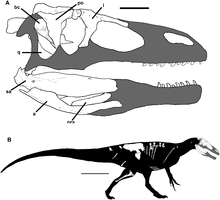Murusraptor
|
Murusraptor Temporal range: Late Cretaceous, 93–89 Ma |
|
|---|---|
 |
|
| Reconstructed skull and skeleton | |
| Scientific classification | |
| Kingdom: | Animalia |
| Phylum: | Chordata |
| Class: | Reptilia |
| Clade: | Dinosauria |
| Order: | Saurischia |
| Suborder: | Theropoda |
| Clade: | †Megaraptora |
| Genus: |
†Murusraptor Coria, Currie, 2016 |
| Species: | †M. barrosaensis |
| Binomial name | |
|
Murusraptor barrosaensis Coria, Currie, 2016 |
|
Murusraptor ("wall thief") is a genus of carnivorous megaraptoran theropod dinosaur from the Sierra Barrosa Formation, part of the Neuquén Group of Patagonia, in Argentina, South America. It is known from a single specimen that consists of a partial skull, ribs, partial pelvis, leg and other assorted skeletal elements.
The holotype of Murusraptor is estimated to be 6.4 m (21 ft), but is considered to be an immature specimen, as the cranial sutures in its braincase have not yet disappeared; this indicates it would have been potentially larger. Analysis of the skeleton further revealed anatomical features as-yet unseen in Megaraptora, particularly in the skull and hips. Analysis of the posterior of the skull indicates that, possibly like the related Megaraptor, Murusraptor likely had an elongated and narrow snout. Interestingly, the sacral ribs are hollow.
Coria & Currie established some distinguishing traits of Murusraptor. The front branch of the lacrimal is longer than the descending branch is high. In the lower jaw, the surangular shows a bone shelf at its outer side, under the groove between the front surangular opening and the notch for the upper rear branch of the dentary, contributing to the side joint. The sacral ribs are hollow and tube-like. The ischia are short, transversely flattened and vertically slightly widened. These last two traits are unequivocal autapomorphies, unique derived qualities, as they are unique within the entire Theropoda.
Furthermore, a unique combination of traits is present that are in themselves not unique. In the braincase, the processus basipterygoidei are situated at the front underside of the basisphenoid while the entrance of the deep depression of the recessus basisphenoideus is directed obliquely upwards and to the rear. The basisphenoid shows a shallow wide notch between the tubera basilaria and the processus basipterygoidei. The chevron bones are rather straight.
In 2001, Sergio Saldivia, preparator at the Museo Carmen Funes, thirty kilometres northeast of Plaza Huincul in a canyon wall discovered the skeleton of a theropod dinosaur new to science. During that year and 2002 the remains were secured.
...
Wikipedia
